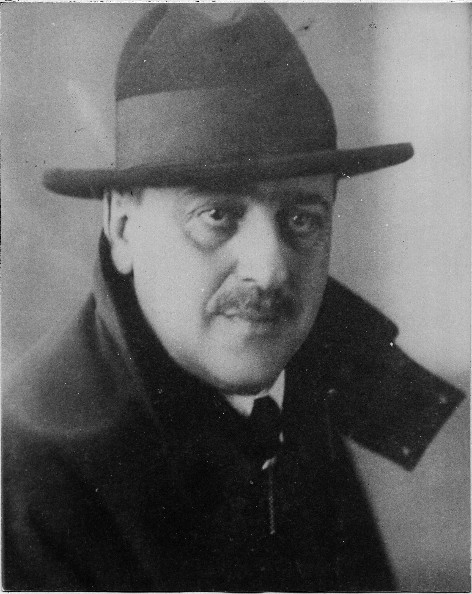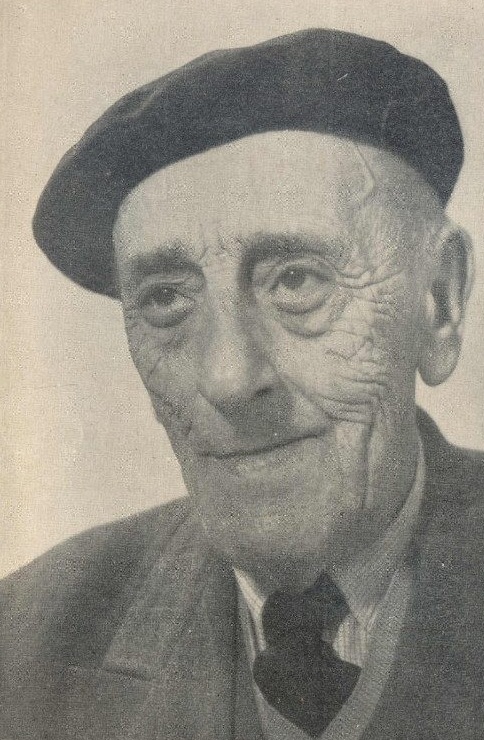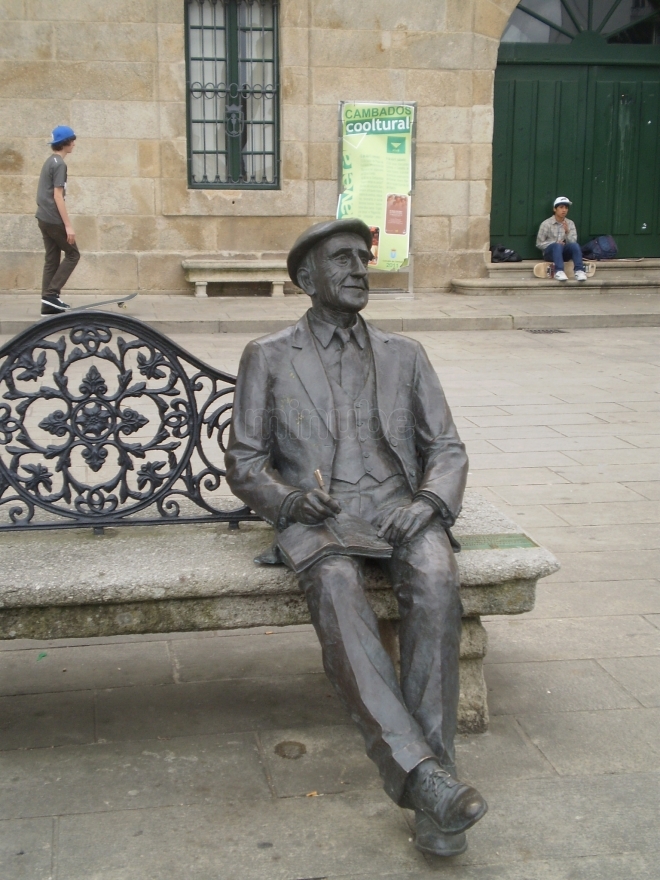<Back to Index>
- Writer Ramón Cabanillas Enríquez, 1876
PAGE SPONSOR



Ramón Cabanillas Enriquez (Cambados, June 3 of 1876 - ibid, November 9 of 1959) was a Spanish poet in the Galician language. Considered within the Galician literature as the link between the Rexurdimento and the literary modernism of the twentieth century, critics usually fit him well in a middle generation, the so called Xeración Antre Dous Séculos ("generation between two centuries") or as a member of the literary generation arising from the inspiring Fala Irmandades .
After abandoning the ecclesiastical career in Santiago de Compostela, he returned to his hometown, Cambados, where he worked as an official of the City. At thirty - four years of age, he emigrated to Cuba, where he lived between 1910 and 1915. There he met Basilio Alvarez, who fought for the agrarian cause, and Fontenla Xosé Leal, who was key to his starting writing in Galician. In Havana published Banished No (1913) and Mareiro Vento (1915).
Back in Galicia, he worked in several municipalities and got acquainted with the agrarian struggle. The commitment to the project of the Irmandades da Fala led him to work assiduously in A Nosa Terra, becoming the lyrical voice of the movement. Initially he held more traditionalist positions but was soon influenced bu Vicente Risco, whose aesthetic design he followed.
He was hailed as Poet da Raza and used his poems to service galleguismo abandoning intimate echoes present in his early poetry. Thus in Da terra asoballada ("From the subdued land", 1917, second edition 1926, included only four poems of the first edition, with a more critical social outlook) and new editions of the poems published in Havana, Cabanillas maintained an educational attitude. He tried to educate the people and bring them closer to nationalism. With these same goals wrote, for Antón Villar Ponte, the dramatic piece "A man of Santiña" (1921). In collaboration with him in 1926 he composed historical tragedy "O Marshal" on the execution of Marshal Pardo de Cela. But by the Catholics of the cathedral of Mondoñedo, it was billed as the revenge of the central Castilian against feudal Galicians. In 1926 he published the poems "Na noite estrelecida ', where, following the theories of Risco, Cabanillas reworked myths of the Arthurian cycle. This is a collection of poems that was considered by Cabanillas himself as the highlight of his work, something that is accepted by many contemporary critics.
The refined language, the constant concern for a clear formal modernist affiliation, although the poet is more "galleguiza" than a modernist - they serve a mythical patriotic exaltation: the Arthurian world, galleguizado also functions as a true reference to the new knights of the Grail, embodied by the reformist movement of Irmandades da Fala. Already in 1927, Cabanillas recovers intimate lyricism with the publication of "A central pink fuck", perhaps the most manifest text where rosalianos echo.
In 1920 he was elected to the Royal Academy of Galicia. For his induction he read a speech titled "The sadness in the Galician poets". In 1929 would ascend to the Royal Spanish Academy with an essay on Eduardo Pondal. Installed in Madrid since joining this institution, the poet went through a long period of silence that would break in the late forties with "ways no tempo" (Roads in time). Thus began a new era with the works "Antiphon gives Cantiga" (1951), "da Mina zanfona" (1954), "Verses terras and tempos alleas gone" (1954) and 'Samos' (1958), his last book published in his lifetime.
Cambados died in the November 9 of 1959. Today his remains are deposited in the church of Santo Domingo de Bonaval, in the area known as the Pantheon of Illustrious Galicians, in Santiago de Compostela
Described by his peers as generational Poet da Raza (Poet of the race) and valued as the legitimate successor of Rosalia de Castro, Eduardo Pondal and Curros Enriquez, Cabanillas was an author of popular and academic recognition. He contributed into bringing Galician poetry to modernity and his work was considered at an early stage within the canon of Galician literature.
Although in its early work he adopted a radical tone in the context of agrarian struggles of the 10s, Cabanillas eventually aligned with the most conservative and least political of Irmandades, known as group Nos. His traditionalism traits as seen in his religiosity, his rural conception of Galicia and skepticism of any system of government, without essential ideological distinctions between them.
Follower of the ideological aestheticism of Vicente Risco, Cabanillas' poetry expresses this culturalism, with myths developing identifiers and symbols looking into the Galician national consciousness.
Critics have pointed out as basic elements of his writing the following: the Greco - Roman classical tradition ((Paraphrase Galegas) (1955) and Samos (1958)), the Galician folk tradition (Antiphon, 1951); Rexurdimento teachers (especially, Rosalia and Curros Pondal) and, especially, the late romanticism (Heine and Rosalia de Castro) and the symbolism and post - symbolism.
The original, in the context of Galician literature, approach to literature of modernism was prompted by his stay in Cuba between 1910 and 1915. Cabanillas's modernism is mostly formal: versatility metric topical content (aristocratic environments, exoticism ...), sensuality, musicality, melancholy verbal preciousness, etc.., His commitment to folklore, narrative and rural lexicon, and ethical orientation and conscience, separate him from a deeper modernist aesthetic.
Also, once inside Irmandades, Cabanillas was influenced in the twenties by saudosismo Portuguese, which is expressed by a greater focus on historical themes, mythology and mysticism between Christian and pantheistic.
Finally, his mature work shows influences of his reading of William Butler Yeats, the thought of the Irish Literary Society and Alfred Tennyson, responsible for his interest in Arthurian mythology.
In the literary career of Ramón Cabanillas four phases can be distinguished:
- Formation stage or pregalleguista (1910 - 1915): intellectually, at this phase a pregalleguista thought is detected, especially if one considers that these years, for economic reasons, he was in Cuba, where he began publishing. However, his texts are written in Galician and animated by Galician circles on the island. During this period, he published his first two books: No banished. Galician Visions (1913) and mareiro Vento (1915), heavily influenced by Rexurdimento literature, especially Rosalie and Curros, for metric innovations of the modernism of Ruben Dario, while imitating the tradition with the use of popular meters and classics.
- Galleguista stage (1916 - 1920): In this stage Cabanillas is at the service of the ideology of Irmandades and the poet becomes purely civil. His poetry loses the aggressive pro-agrarian stage and adopts a didactic aim to raise awareness of the great figures of Galician culture (Rosalia Pondal, branes, Lois Porteiro ...) in order to claim the Galician national pride; in this sense, Cabanillas addresses the conflict as Galicia - Castilla in many of his poems, symbolizing both regions in the roles of oppressed and oppressor, respectively. As motifs characterizing the Galician identity, appear at this stage as language issues, the Celtism, the reference to Irish model, etc. Significant work is Da terra asoballada (1917) - From the overwhelmed earth.
- Saudosista mythical stage (1921 - 1930): Following Vicente Risco's culturalism within Irmandades, Cabanillas tries to write a poem mythologizing the past with saudosista perspective. It adopts the genre of narrative poetry, and writes noite estrelecida Na (1926), updating the Matter of Britain with patriotic and Christian overtones. Cabanillas exposed at this stage a poetic vision of Galicia formed at Celtic and medieval times, with the Spanish domination bringing the failure of the national aspirations of Galicia. Stylistically, Cabanillas uses symbols and numerous scholarly references, including the use of verses as the Alexandrian cults.
- Postconflict or mystic (1939 - 1959): in the forties, Cabanillas began a second literary maturity, influenced by poets like Antonio Machado and historical events as the Spanish Civil War and post war repression.To this time belong the works gives cantiga Antiphon (1950), a recompilation of popular ballads, and zanfona da Mina (1954), bitter poetry that speaks in a moralizing tone of sadness, lost youth, life and death ... As a result of his stay in the monastery of Samos, he wrote Samos (1958)